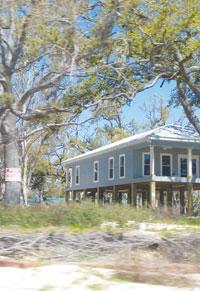While TV cameras showed scene after desperate scene of America’s gulf coast being ravaged by hurricane Katrina, they passed over a handful of accomplishments throughout the area, but one dedicated group of UMass Boston students made certain not to make the same mistake.
A class of 22 UMass Boston undergraduates and one graduate student traveled to East New Orleans and Biloxi, MS between March 16 and March 23 to assist in the rebuilding effort within the region’s Vietnamese American community. The class is called Resources for Vietnamese American Studies (AsAmSt 294), and is taught by longtime Asian American Studies instructor James Bui.
For Jennifer Nguyen, the course’s graduate student and teaching assistant, this will be the third time going down, and in that time she noticed a lack of recognition towards the Vietnamese American community from the mainstream media that exists and is felt deeply throughout the Gulf Coast communities.
“In the mainstream media you don’t hear about the Vietnamese American community,” said Nguyen, who traveled to New Orleans twice before to document stories and photos of experiences from living through Katrina. “If you are working within the urban planning community, then they are painted as the ideal group because this group just went ahead and did their planning process without waiting for the city or waiting for funding, instead saying ‘ok, this is what we want our community to look like.'”
The class traveled to the Gulf Coast with five goals in mind: to survey Vietnamese Americans living in FEMA trailers to see what they planned for August when FEMA officially cuts funding for those trailers, to help former business owners in the community formulate models in order to restart their operations, to help grow the community garden that will be used to grow and sell produce at the local farmer’s market, to investigate claims of illegal dumping in Versailles’ Vietnamese American community and to purchase and redevelop real estate in the East New Orleans and Biloxi districts.
Although unable to go in March, Dr. Peter Nien-chu Kiang, professor of education and the director of Asian American studies at UMass Boston, remains quite proud of the work the class did down there because the effect of their work will be much more significant in reorganizing the infrastructure of the Vietnamese American communities around the Gulf Coast.
“It was an issue all along because with FEMA [at the federal, state and local levels of government] there was nobody who could speak Vietnamese,” said Kiang, who did not travel to the Gulf Coast this time but made both trips in the past. “These are immigrant Vietnamese speaking populations. That’s one reason that our students could make a difference because many of them are bilingual themselves.”
Despite the fact that the communities seem to be doing very well to rebuild, one seems much more so than the other. New Orleans’ Vietnamese American population has taken great strides to plan and organize in their restructuring, while the community in Biloxi does not seem to have the same impact. Kiang feels this is due, in part, to the fact that the Vietnamese American people of New Orleans have a church to structure themselves around, while the Biloxi community has nothing to that effect.
“Biloxi is both a smaller community, and does not have the organizational capacity in the community, so their rebuilding is sort of haphazard,” Kiang said. “In Biloxi there is no one institution like that [Church]. There are a couple of churches, there are a couple of temples, but the population is not nearly as tight, and it is also a lot smaller so there is no critical mass.”
Nguyen recognized this truth on her last trip, but feels that the divide is much more symptomatic of a sort of cultural divide between New Orleans and Biloxi. The beginning of New Orleans’ Vietnamese American community began after the Vietnam War, when a large movement of North Vietnamese people migrated south to Saigon in the 1950s in order to escape the communist takeover in the North. It wasn’t until the 1970s, when Saigon fell to the North Vietnamese Army, and Vietnamese people began to migrate to the United States. These immigrants were led to New Orleans by a local parishioner of Vietnamese heritage, but many fishermen opted for job opportunities in Biloxi, a major fishing haven on the Gulf Coast.
“The New Orleans [Vietnamese] community is distinct in that they have a shared history that goes back,” Nguyen said. “The job [in Biloxi] appealed to new immigrants with limited English skills, who had limited job skills. So people moved to Biloxi for economic reasons, and people moved to New Orleans for the community reasons, so it is a very different dynamic.”
East New Orleans, known as Versailles, and Biloxi are two areas along the Gulf Coast with a strong concentration of Vietnamese Americans that prior to Katrina reached around 7,000 people in Versailles, and 4,000 in Biloxi. But since the flooded devastation of those August and September days in 2005, the Vietnamese American communities have dwindled to 6,000 and 1,000 in Versailles and Biloxi respectively.





















































